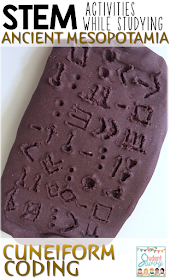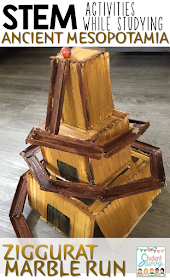Right now I'm in the process of creating a series of STEM projects for students who are studying Ancient Civilizations.. First stop, Ancient Mesopotamia!
Ancient Civilizations has to be my favorite curriculum to teach. I find the ancient world fascinating, with all the different traditions, inventions, rituals, building structures, gods and goddesses. I could probably spend the whole year just focusing on Egypt alone, with its pyramids, their social hierarchy with pharaohs, and interesting process of mummification. I get excited knowing that the information about these civilizations that existed in 3000-1000 BC are still being uncovered by archaeologists today. I love sharing my excitement and enthusiasm about Ancient Civs!
Here's the STEM challenge for your students: STEM groups must first make the play-dough to create their cuneiform tablet. After painting their tablet, students must decide on symbols
that represent each letter of the alphabet. They must create an answer key of their symbols that correlate with the letters A-Z. Using a sharp pencil as a stylus, students will carve their symbols into their tablet, creating a coded message. Students must work together as a team to come up with their secret message. The message must be a fact about Ancient Mesopotamia and it must contain at least 5 words. When multiple groups are finished, they will give the Cuneiform tablets to each other and try to guess what the other group’s message is.
Ziggurats
were the most prominent buildings in the Sumerian cities. The Sumerians
believed that the gods and goddesses were in charge of their cities.
They built the Ziggurat structures because they wanted to place their
temples on a high platform, closer to the heavens where the gods lived.
This resource is also part of the Ancient Civilizations Complete Curriculum.
The curriculum package contains Ancient Civilization STEM Challenges,
Interactive Notebooks, PowerPoints, Google Classroom Projects, and
Assessments. The units covered include Ancient Mesopotamia, Ancient
Egypt, Ancient Israel, Ancient India, Ancient China, Ancient Greece, and
Ancient Rome! There are over 700 pages of interactive material.
 Suzanne is a full time curriculum designer on Teachers Pay Teachers and the author of the blog TeachStudentSavvy.com.
She is a California credentialed K-8 teacher and is committed to
creating effective and engaging teaching resources for the elementary
classroom. Suzanne lives in Northern California with her husband Matt
and two dogs, Mochi and Mindy. As a curriculum designer, her goal is to
provide educational tools that make teachers lives a bit easier and that
students will love and enjoy using in the classroom. Be sure to visit
her on Pinterest, Facebook, Instagram, and at her TpT store!
Suzanne is a full time curriculum designer on Teachers Pay Teachers and the author of the blog TeachStudentSavvy.com.
She is a California credentialed K-8 teacher and is committed to
creating effective and engaging teaching resources for the elementary
classroom. Suzanne lives in Northern California with her husband Matt
and two dogs, Mochi and Mindy. As a curriculum designer, her goal is to
provide educational tools that make teachers lives a bit easier and that
students will love and enjoy using in the classroom. Be sure to visit
her on Pinterest, Facebook, Instagram, and at her TpT store!



No comments:
Post a Comment